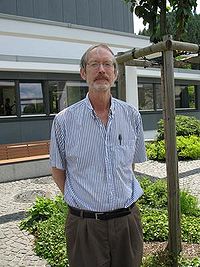Robert Duncan MacPherson (born May 25, 1944) is an American mathematician at the Institute for Advanced Study.
Robert MacPherson | |
|---|---|
 MacPherson at Oberwolfach in 2008 | |
| Born | May 25, 1944 |
| Nationality | American |
| Alma mater | Swarthmore College Harvard University |
| Known for | Intersection homology |
| Awards | NAS Award in Mathematics (1992) Leroy P. Steele Prize (2002) Heinz Hopf Prize (2009) |
| Scientific career | |
| Fields | Mathematics |
| Institutions | Massachusetts Institute of Technology Brown University Princeton University |
| Doctoral advisor | Raoul Bott |
| Doctoral students | Mark Goresky David Nadler Julianna Tymoczko Kari Vilonen Zhiwei Yun |
Early life and education
editRobert Duncan MacPherson was born in Lakewood, Ohio on May 25, 1944.[1]
He received his bachelor's degree from Swarthmore College in 1966.[1] MacPherson received his PhD from Harvard in 1970 with a thesis, written under the direction of Raoul Bott, entitled Singularities of Maps and Characteristic Classes.[2]
Career
editMacPherson was at Brown University as a J. D. Tamarkin Instructor from 1970 to 1972, an assistant professor from 1972 to 1974, an associate professor from 1974 to 1977, and then a professor from 1977 to 1987.[1] He was a professor at the Massachusetts Institute of Technology from 1987 to 1994.[1] He became a professor of mathematics at the Institute for Advanced Study in 1994, later becoming named a Hermann Weyl Professor.[1] He retired and became a professor emeritus 2018.[1]
His notable doctoral students include Mark Goresky, David Nadler, Julianna Tymoczko, Kari Vilonen, and Zhiwei Yun.[2]
Research
editMacPherson and Goresky introduced intersection homology.[3] He also worked on arithmetic groups, in particular on Siegel modular threefolds with Mark McConnell and on compactifications of symmetric spaces with Lizhen Ji.[4]
Honors and awards
editIn 1983, MacPherson gave a plenary address at the International Congress of Mathematicians.
In 1992, MacPherson was awarded the NAS Award in Mathematics from the National Academy of Sciences.[5] In 2002, he and Goresky were awarded the Leroy P. Steele Prize for Seminal Contribution to Research by the American Mathematical Society.[6][7] In 2009 he received the Heinz Hopf Prize from ETH Zurich.[1]
In 2012, he became a fellow of the American Mathematical Society.[8] He is also a fellow of the National Academy of Sciences and the American Academy of Arts and Sciences.[1]
He received honorary doctorates from the University of Lille in 1993 and Brown University in 1994.[1]
Personal
editMacPherson's PhD advisee, Mark Goresky, later became his life partner.[3] After the collapse of the Soviet Union, they were instrumental in channeling aid to Russian mathematicians, especially many who had to hide their sexuality.[3]
Selected publications
edit- Goresky, Mark; MacPherson, Robert, La dualité de Poincaré pour les espaces singuliers, C. R. Acad. Sci. Paris Sér. A-B 284 (1977), no. 24, A1549–A1551. MR0440533
- Goresky, Mark; MacPherson, Robert, Intersection homology theory, Topology 19 (1980), no. 2, 135–162. doi:10.1016/0040-9383(80)90003-8 MR0572580
- Goresky, Mark; MacPherson, Robert, Intersection homology. II, Inventiones Mathematicae 72 (1983), no. 1, 77–129. doi:10.1007/BF01389130 MR0696691
References
edit- ^ a b c d e f g h i "Curriculum Vitae". Robert D. MacPherson. Retrieved May 14, 2024.
- ^ a b Robert MacPherson at the Mathematics Genealogy Project
- ^ a b c "Robert D. MacPherson". Simons Foundation.
- ^ Gunnells, Paul E. (2006). "Robert MacPherson and Arithmetic Groups". Pure and Applied Mathematics Quarterly. 2 (4): 1015–1052. arXiv:math/0603385. doi:10.4310/PAMQ.2006.v2.n4.a5.
- ^ "NAS Award in Mathematics". National Academy of Sciences. Retrieved February 13, 2011.
- ^ "Notices of the AMS 2002 p. 466" (PDF). ams.org.
- ^ "List of Steele Prizes Seminal Contribution to Research". www.ams.org.
- ^ List of Fellows of the American Mathematical Society, retrieved February 2, 2013.
External links
edit